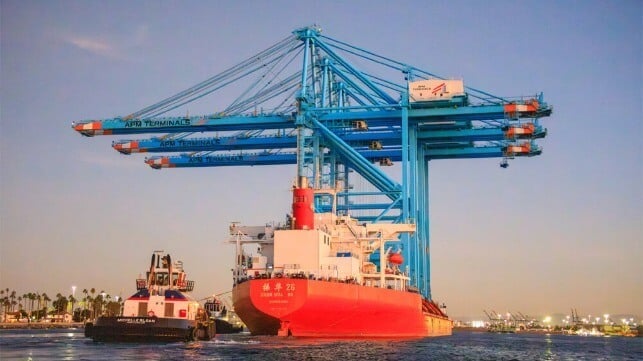Ports: USTR Fees on Chinese Cranes Will Not "Magically" Revitalize Industry

The American Association of Port Authorities continued to fiercely advocate for ports during its testimony and response to the U.S. Trade Representative’s proposal to add fees on Chinese-built ships, car carriers, and Chinese-manufactured port cranes. AAPA, which has been fighting against the fees on cranes, said today, May 19, during the USTR testimony, “raising tariffs on Chinese cranes another 100 percent will not magically revitalize an American crane manufacturing industry that has been nonexistent for decades.”
Advocating on behalf of port operators, AAPA CEO Cary Davis said the industry “still has serious concerns about the economic consequences” of the revised USTR proposal issued in April for the fees to punish China for its policies to control the shipping industry and logistics through its subsidies of shipbuilders and ZMPC, China crane manufacturer which dominates the industry. Davis acknowledged positive changes versus the first draft, but voiced strong opposition to the fees on crane imports and all foreign-built vehicle carriers. AAPA estimates the proposals could cost ports nearly $7 billion in fees.
"Applying a new 100 percent tariff to Chinese STS cranes will not create a domestic crane manufacturing industry out of thin air," stated Davis in official comments submitted to the Federal Register. "It will only increase costs for public port authorities."
AAPA called the proposed additional fees on Chinese-manufactured port cranes “a tax on port development.” It highlights that port operators can not “easily shop around for a better price,” because ZMPC controls 70 percent or more of the market, and the other manufacturers do not have the production capacity to replace ZMPC. It highlights that the only options are Mitsui, Konecranes, and Liebherr.
The trade group is calling on the USTR not to make the fees retroactive so that they cover cranes ordered before the April 17 release of the proposal. “Applying this tariff to cranes that are already contracted for delivery will not discourage China’s unfair manufacturing practices or encourage American manufacturing of STS cranes,” said Davis.
As an example, it cites the Port of Houston, which it says is facing “grim circumstances.” Houston has eight cranes at a cost of $14 million each ($112 million total) contracted for delivery in the spring of 2026. AAPA says that with all the proposed tariffs, Houston’s cost would skyrocket to over $302 million.
It is also calling for a one-to-two-year delay on the tariff while supporting an effort to have Congress establish a tax credit to encourage domestic production. It also points out ambiguities in the rules, such as whether cranes would also face the reciprocal tariffs and fentanyl tariffs separately imposed by Donald Trump. In 2024, the Biden administration also imposed 25 percent tariffs on Chinese STS cranes.
AAPA is equally strong in its opposition to the fees on cars carried on foreign-built vessels, saying that if it had been in the first draft, there would have been strong opposition broadly across the industry. It says those fees will impose “severe harm on the port communities that specialize in the automotive trade.” While questioning if these fees are within the authority of USTR, it also points out that there is no method to distinguish imports from exports, as these car carriers offload foreign cars and load U.S. cars for export.
Similarly, it asserted to USTR that the quota of exported LNG on U.S.-built vessels is “infeasible and will cause instability.”
AAPA told USTR it supports the idea of reshoring to the U.S. but said it must be done more strategically, not to hurt ports, American industry, and consumers. It was one of the speakers commenting today on the second draft of the fee proposal. USTR is expected to finalize the proposal and move forward with implementation, which could happen as early as mid-October.
